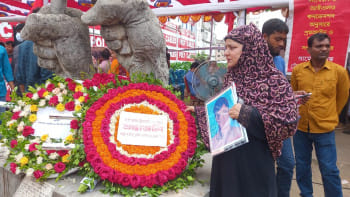Editor's Note
With this issue of Forum, we draw the curtain on this publication. Seven years since its inception that the monthly magazine has been in continuous print, it does sadden us to bring it to a close. Much that we would have liked to continue with this serious publication replete with in-depth analyses and commentaries based on insights gained through expertise, experience and research, like all good things, it too has to come to an end.
We express our gratitude to the contributors who have been highly regarded in the intellectual circles for their integrity and commitment, due diligence and authenticity with which they have been writing for us. We promise to sustain the interactive relationship between the Forum team and contributors in some form or the other.
Since a good living newspaper is embarked on a quest for variety, certain repackaging may be necessary to enliven an established daily with new content and in fresh forms. So, we will keep serving the people's right to know in whatever manner we can with all the professionalism we can muster. That is our unflagging commitment to the valued readers and patrons.
So much for the valedictory sentiments; we now turn to the content of the last issue. The youth movement at Shahbagh square that ignited people's imagination in its origin and to some extent its evolution has added an entirely new dimension to our understanding of the potential power of the young. It has been interpreted as being atypical, apolitical, neutral and conscionable in terms of embracing the liberation war ethos topped up by demand for justice to the victims of crimes against humanity.
"Fighting as we still are over different narratives of 1971, we won't cease to fight over the different narratives of Shahbagh either," reminds one of our writers. Attempts have been made by fanatics to taint the Projonmo Chottor in a strange but predictable manner. The vested quarters sought to make it appear as a tug of war between 'atheism' and religiosity. The people, of course, did not buy into such a ploy and the Projonmo Chottor in its non-violent mode adopted a persuasive approach to allay misgivings in the detractors' mind.
However, the dichotomy of the dual identity between ethnicity and religion may have resurfaced after 1971. 'Any coddling with religious extremism giving indulgence to fanaticism' will have to be scrupulously avoided, if we are to tackle the unfortunate identity conflict along ideological lines. The ramparts of secularism will have to be strengthened through plugging the fault lines.
The Islamist agendas have been 'unpacked' centred on support base and along pragmatist/opportunist, idealist and orthodox, pir-centric and mazar-based, urban elite-centric and jihadist lines.
Naeem Mohaiemen says, "As he dug into the archives, he was struck by the expanding scope of censorship and the concomitant weakness of the media." Thus we have a fully-fledged chronicle of censorious behaviours of successive governments since 1971.

 For all latest news, follow The Daily Star's Google News channel.
For all latest news, follow The Daily Star's Google News channel. 



Comments